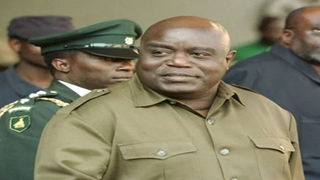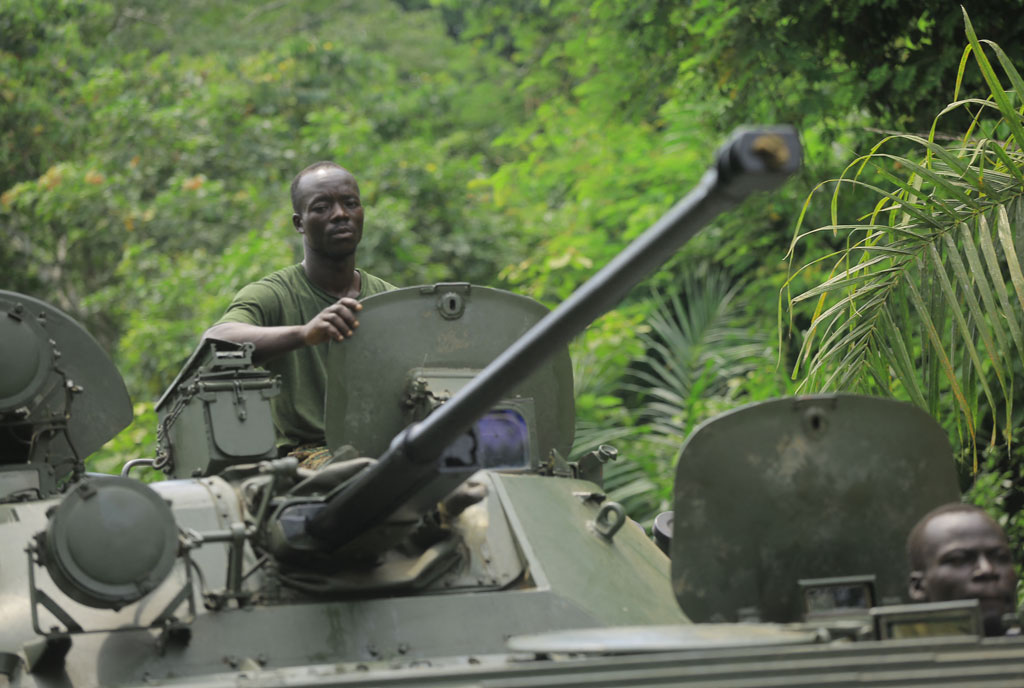
Former Democratic Republic of Congo president Laurent-Desire Kabila leaves a summit in Victoria Falls, Zimbabwe, on August 8, 1998. PHOTO/AFP
|Special Reports
Prime
Africa's forever war: Kabila assassination worsens DRC crisis
What you need to know:
- In the last instalment of the series, Emmanuel Mutaizibwa reconstructs the murky details around how President Laurent Kabila was assassinated.
President Laurent Kabila of the Democratic Republic of the Congo (DRC) spent the Saturday afternoon of January 16, 2001 in his office at Marble Palace. He was likely contemplating losses suffered in the Second Congo War when a young man armed with a concealed revolver pistol approached him.
About three gun-shots rang out, leaving the giant frame of Kabila slumped in a leather armchair. The killer would later be identified as Rachidi Kasereka, a young man who was part of the presidential guard coterie. He was liquidated immediately, with multiple accounts alleging that Col Eddy Kapend, Kabila’s aide-de-camp, pulled the trigger.
It remains a mystery why Kasereka wasn’t captured and interrogated to reveal those behind the assassination. Many in fact reckon the actual killer and other putschists fled to Congo-Brazzaville.
French newspaper Le Monde reported that the plot to kill Kabila was hatched in Congo-Brazzaville by 75 dissenting kadogos (child soldiers) who helped Kabila capture power. The blueprint was titled ‘Operation Mbongo Zero.’ Mbongo is a Swahili noun that was descriptive of Kabila’s obesity.
Assassination plan
A copy of the assassination plan has been kept by one of the plotters, identified as ‘Abdoul’. The three hand-written pages, which were not signed, elaborately detailed how the putschists would carry out the attack and seize vital installations. These included the presidential palace, national radio and television station, and the headquarters of the country’s electricity company.
Who wanted Kabila dead? Did the kadogos get a hand from America, which had always viewed Kabila as a Marxist-leaning ultra-nationalist? During his days as a sun-scorched rebel-leader-cum-gemstone-dealer, Kabila kidnapped three Stanford University students at gunpoint from a Tanzanian research camp. He forced them into slave labour and only released them after their families paid nearly a half-million dollars as a ransom. Was his death pay-back time for this offence?
Other theories
A few months before Kabila was assassinated, Anselme Masasu Nindaga, his vastly popular rabble-rousing former chief of staff, who was a Tutsi/Mushi, was along with 47 kadogos put on firing squad in Lubumbashi. Masasu stood accused of being involved with foreign intelligence services, making arbitrary arrests, establishing a private prison and smoking marijuana. James Kabareebe, who would go on to become Rwanda Chief of Defence Staff after falling out with Kabila, replaced Masasu.
Al Jazeera’s television investigations unit film titled ‘Murder in Kinshasa’ offers another side into Kabila’s assassination. Journalists Zajtman and Rabaud concluded that Kabila’s alleged killer, Kasereka, was only one man in a larger plot that included the Rwandan government, a Lebanese diamond merchant whose business had recently been terminated by Kabila, and the tacit approval of the United States (US).
Historian Thomas Turner writes that both Rwanda and the US came to view Kabila as an impediment to the future of the DRC.
Kabila’s killing had also been viewed with the context of dangerous ethnic cleavages. In the eyes of Kinshasa and the Lingala-speaking west of the Congo, Kabila’s regime was based on the Swahili-speaking east. Within the regime, however, a split had emerged between people from Kivu (the provinces of North Kivu, South Kivu, and perhaps Maniema) and those from Katanga.
The official story laid the blame for the assassination on the Kivu people. Then, the finger of suspicion shifted. A number of leading regime figures were arrested on suspicion of involvement in the assassination, including Col Kapend, Gen Nawej, and several others from the Lunda ethnic group.
These arrests brought to the surface the rivalry between the Lunda and the Luba-Katanga, the two leading ethnic groups of Katanga. Laurent Kabila’s Luba (father) and Lunda (mother) ancestry appeared to have bridged the gap.
Beyond the ethnic rivalries, loomed the prospect of a split between DRC’s two main allies. Kapend, a former member of the “Katanga Tigers” and thus an officer in the Angolan army, was seen as Angola’s man in DRC. The danger was that Zimbabwe might side with the Luba-Katanga faction, splitting the pro-Kinshasa coalition.
Coup rumours
In his book, Crisis in the Congo: The Rise and Fall of Laurent Kabila, Francis Ngolet quotes a UN report, which indicated that shortly after Kabila was shot, gunfire was heard around his residence on January 16, 2001 in the Binza suburb of Kinshasa. A helicopter was circling overhead and Kinshasa’s residents were hurrying home. Unusually heavy traffic jams snarled the city’s major avenues.
Rumours of a coup attempt against Kabila began circulating and were fed by a lack of any reliable information about his fate. Western diplomats in Rwanda seemed to have clearer information, announcing that Kabila had been shot in a coup attempt.
As rumours of Kabila’s death circulated, Interior minister Gaetan Kakudji was quick to say the president himself had ordered that a curfew be imposed on Kinshasa.
In Kinshasa, the situation was grave enough for US and British citizens in the DRC to be ordered to remain indoors. The gravity of the situation was further conveyed when Kapend made the following appeal on television: “To the army Chief of Staff, to the commander of ground, air and naval forces and all regional military commanders: I order you to take charge of your units. Until further notice, no guns shall be fired for whatever reason.”
A day later, the New York Times confirmed that Kabila had been killed by one of his bodyguards. Another report claimed the killing involved a dispute between Kabila and his generals. The Belgian state broadcast network RTBF reported from Kinshasa that Kabila had indeed been shot in the back and leg by one of his own security guards and had been transported by helicopter to a hospital in Kinshasa.
No clarity
The Belgian Foreign minister, Louis Michel, confirmed that “two trustworthy sources” told him that Kabila had died. He told RTBF that Kabila’s death was not a coup d’état, but rather “an argument that descended into violence.” US officials said they believed Kabila had been assassinated and urged combatants not to interfere.
There was no indication of who was in charge. The French Foreign Affairs Office declared that they had been in contact with the Belgian government and still did not have definitive information about Kabila’s death.
According to Francis Ngolet, by January 17, the DRC government had “not officially confirmed [Kabila’s death].” Contradictory information from Kinshasa about Kabila’s fate continued to spread.
According to the official announcement by Information minister Dominique Sakombi Inongo on national radio, Kabila had been wounded during an assassination attempt and duly sent to a foreign country by plane for care; his claim contradicted statements made by the Belgian and British governments that the president had died during or soon after the attack.
Minister Inongo also announced the reopening of the airport and a reduced curfew. Taxis and buses started running again and people returned to work all across Kinshasa, but ferry services between Kinshasa and Brazzaville remained closed.
The government reopened the main airport, but most carriers stayed away because of instability. On one of the few planes that flew in and out of Kinshasa, many European and Lebanese women and children could be seen leaving the capital.
Death confirmation
The Zimbabwean State news agency, Ziana, reported that the Zimbabwean defence minister, Moven Mahachi, had said Kabila had died earlier on January 16 en route to Zimbabwe. Mahachi later said he had been quoted out of context but did not withdraw the comments.
A Congolese DC-8 jet was reported to have landed at Harare International Airport on the morning of January 17, and journalists in the capital spent the day trying to locate the Congolese leader.
Regardless, a spokesperson for the Belgian Foreign ministry, Koen Vervaeke, reaffirmed that “two reliable independent sources” said Kabila had died after being shot.
The DRC minister of defence, Godefroid Tcham’lesso, also said in Tripoli that President Kabila had died after being shot in the head by one of his presidential guards. Tcham’lesso explained: “He was said to have fought death for about two hours before he expired.”
Yet on January 18, 2001, the official word from the government remained that Kabila had been shot and wounded. The official announcement finally came later that day when Minister Inongo announced on national television: “The DRC is in mourning and the government of National Salvation has the deep pain and unhappy task of announcing the death of President Laurent-Désiré Kabila today, Thursday, January 18 at 10am.”
Inongo said the whole country would observe 30 days of mourning. He did not clarify the circumstances of Kabila’s shooting, saying only that the president had been a victim of an “attack.” But the emerging media consensus was that Kabila had been hit by several bullets after a row erupted between him and several of his generals over their handling of the protracted war.
The minister also said the late leader had left a testament ordering the armed forces, police, and security forces to maintain discipline and to remain peaceful and calm, to protect the population and to “kick the aggressors out of the national territory.”
The declaration ended two days of uncertainty created by Western and African reports that Kabila was dead while the Kinshasa government officially denied it. Two days after the declaration, the DRC ambassador to Harare, Kikaya Bin Karubi, stated that the following Saturday, Kabila’s body was to be flown back from Zimbabwe, where he had been taken for medical treatment.
State television gave no details about Kabila’s funeral. But the government of Belgium said his body would be flown first to Lubumbashi and then to Kinshasa and that his funeral was planned for January 23, 2001.
Uncertainty
The death of the Democratic Republic of Congo president Laurent Kabila thrust the mineral-rich country into a new uncertainty after three and a half years of brutal civil war and four decades of Mobutu’s predatory rule. On January 25, 2001, Gen Joseph Kabila succeeded his father.
Twenty-two years after Kabila was assassinated, the DRC remains a basket case—a dystopian jungle with hundreds of roaming militias who have killed and maimed thousands of civilians.
As the regional armies and the East African Standby Force have returned to the restive eastern DRC in an attempt to nip in the bud the M-23 rebellion, the fog of war ominously hangs over the future of the mineral-rich country.




